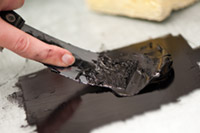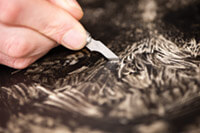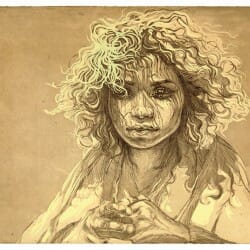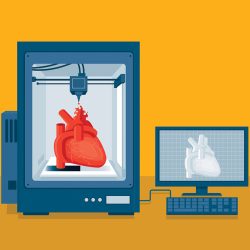Students learn to print with limestone, oil, and ink
Hunched over a block of Bavarian limestone, Greg Luckeroth MFAx’12 is learning to add by subtracting. “Drawing” with an X-Acto knife — a razor-tipped tool shaped like a pen — he scrapes at the design on the block, shaving away bits of grease to refine the image that will be his final project.
Luckeroth is a student in Art 316: Lithography. Taught by Professor Jack Damer, the course combines artistry, history, science, and technology to help students learn a printing process that seems ancient but is actually quite modern.
“A lot of students are turned off by working with stone in the twenty-first century,” Damer says. “But the process was created in 1798, making it one of the newest forms of printmaking.”
Lithography literally means writing with stone, and it’s the basis of today’s offset commercial printing. Metal plates replaced stones long ago in the commercial world, but traditional lithography is still embraced by artists. Damer teaches his students to use both traditional stone and metal plates.
In traditional lithography, an artist creates imagery with grease-based material on the limestone surface. He or she then wets the image and applies printing ink, which sticks to the grease but not to the ungreased parts of the stone. The artist may then make multiple prints of that image by repeating the inking process. When finished, he or she can prepare the stone for a different project by abrading it to create a clean surface.

Lithography class involves teaching students a variety of skills, such as how to mix ink in preparation to print (above) and how to create an image by applying, then scraping away, greasy materials (below).
Damer’s class sizes are relatively small, with between eight and twenty students enrolling at a time. And though ink isn’t expensive, blocks of lithograph limestone are small treasures, and costs can run from $1,000 to $4,000, depending on the size of the block.
Damer, who says he’s always been interested in printmaking, has been practicing lithography for more than four decades, though he admits the demands of teaching limit his time to work as a print-maker. “The process is simple,” he says, “but it’s tricky, because of the chemical nature. A lot of my teaching is solving technical problems for the students.”
But for those who learn the intricacies of lithography, the print form can become a passion. “It’s kind of a magical process,” Damer says. “People either dislike it, or they get hooked on it.”
Published in the Spring 2011 issue





Comments
No comments posted yet.